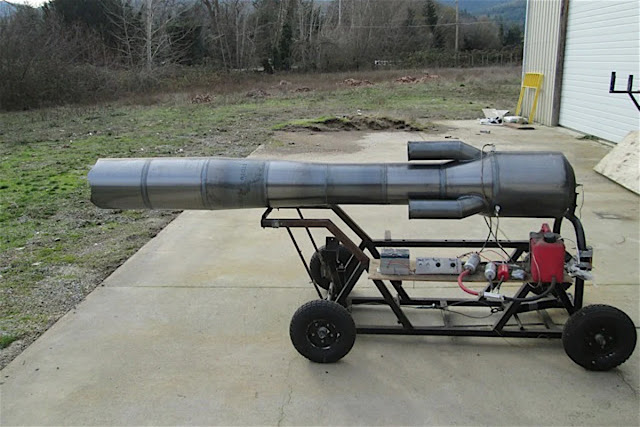STAGE - 1
After delving on Google for the evening we decided we needed something more than the run of the mill type of flame thrower. Most of the working suggestions out there were stable, safe and unfavorably everyday.
The words of Sir Stirling Moss came to mind - "To achieve anything in this game, you must be prepared to dabble on the boundary of disaster." (see Quote)
Well, what makes a flamethrower so impressive and so awesome?
Is it not the flash of uncontrolled flames suddenly billowing out from nowhere?
Is it not the unexpected noise created by unburnt fossil fuel exploding to live?
Is it not the thrill of dabbling and playing with fire?
Yes, dabbling on the brink of disaster!
And so off we marched to the dark side of the web. And "Oh Boy" what did we find?
Technology from the Second World War that can with some "dabbling" be married to a modern day remote control system.
This out of the ordinary Flame Thrower would need the following main components.
1 Pulse Jet Engine - Fueled by LPG. ( Mixture of Butane + Propane.)
2 LPG Fuel Cell - 20 liters.
3 Afterburner - To provide an increase in thrust - flames.
4 Flame Halo - Used to spray a raw diesel / petrol mixture into the afterburner.
The Flame Halo will serve as the heart of the flamethrower.
Mounted in the afterburner and activated when the petals are extended this will dispense a copious shower of raw unburnt fossil fuel mixed with high pressure LPG gas.
The pulse jet engine serves as a high volume ignitor and burner.
Imagine a pulse jet engine glowing cherry red while it screams blue murder, the noise so intense, the sound vibrations so extreme that it takes your breath away. Suddenly the engine warning light starts to flash, the petals on the afterburner extend to the fully open position. Immediately the engine pitch becomes hysterical. A split second later this volatile living engine spews out a pure ball of unadulterated flames.
What more can you ask for?
No 1 - Pulse Jet Engine.
What is a "Pulse Jet Engine?"
Well here is a simple description and explanation of its workings.
The million dollar question being - well how do we turn this marvelous piece of invention into an awesome Flamethrower?
Well for one, it needs to be smaller, much smaller, say something similar to what is used by model jet engine builders.
No 2 - LPG Fuel Cell - 18 liter.
Why chose LPG?
LPG is one of the cleanest conventional fuels available. LPG demonstrates lower GHG (Greenhouse Gas) emissions than coal, wood and electricity on an energy-equivalent basis. LPG produces less air pollutants than diesel, oil, wood or coal.( That's enough of the Green Talk Buddy)
Also here in Australia, LPG is a very affordable and economical fuel source, costing on the average 65 cent/liter. ( Read more here )
This commercially available LPG cylinder stores 18 liters of fossil fuel in liquid gas form.
LPG gas is stored at a pressure of 800 kPa or 120 psi.
When pressure is released from the cylinder the liquid petroleum has a temperature of minus 43 DEG.
Below is a cylinder purchased to fuel our LPG powered pulse jet rocket engine.
The brass fitting in the middle with the black cap is the Servo or Gas Station filling point.
No 3 - Afterburner - Thrust Multiplier.
What does a jet afterburner do?
Described in the following way - An afterburner ( or reheat ) is an additional component present on some jet engines, mostly military supersonic aircraft. Its purpose is to provide an increase in thrust, usually for supersonic flight, takeoff and for combat situations. Afterburning is achieved by injecting additional fuel into the jet pipe downstream of the turbine.
How does an Afterburner work on a jet engine?
The idea behind an afterburner is to inject fuel directly into the exhaust stream and burn it using the remaining oxygen. This heats and expands the exhaust further, and can increase the thrust of a jet engine by 50% or more. This is a fuel hungry component, but the trade-off for instant thrust is irresistible.
Watching the afterburner open or expand to the full thrust position highlights the intricacy of this simple looking component, yet complexity in design.
The design and operation of the afterburner will be an engineering challenge we look forward to.
Injecting high pressure liquid gas into the combustion stream will be the biggest challenge.
Don't forget there is also the ever dreaded "flame out" that looms in the equation!
Even worse - Complete meltdown.
Talk about dabbling on the brink of disaster!









No comments:
New comments are not allowed.